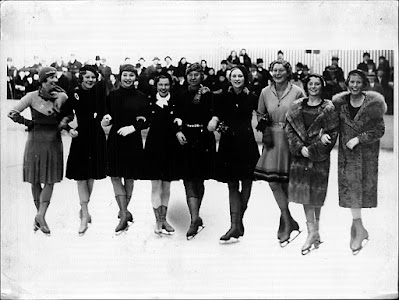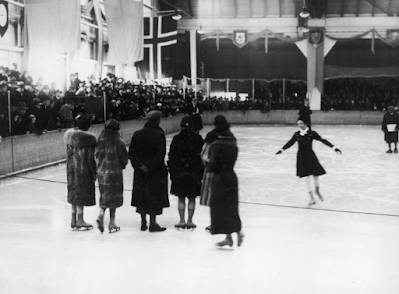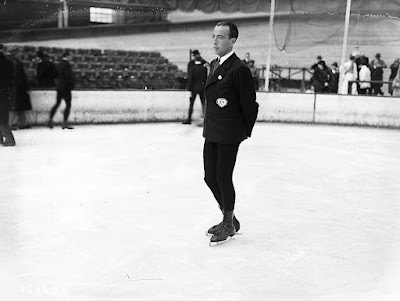Sonja Henie receiving an award in Stockholm. Photo courtesy National Archives of Poland.
The Swedish organizers spared no expense, concluding the event with a lavish banquet at the Grand Hôtel Royal every single competitor and judge received souvenirs and prizes. Held the week after the Swiss Winter Sports Week in Zürich, the men's event at the Doldier Stadion was held with much less fanfare. One of the more interesting footnotes from this events was the fact that professional skater Phil Taylor - Megan Taylor's father, entertained the Swedes with an exhibition... a rarity in an ISU sanctioned competition in a period where the strict rules of amateurism were constantly espoused. Hop in the time machine as we take a brief look back at the stories and scandals from this competition of yesteryear!
THE PAIRS COMPETITION
Photo of Stockholm venue. Courtesy National Archives of Poland.
The most interesting story surrounding the pairs competition at the 1933 World Championships had more to do with who didn't attend than who did. Former Olympic Gold Medallist and World Champion Lilly Gaillard (Scholz) was one of the most decorated pairs skaters of her era and had won an incredible five consecutive medals with her first partner, Otto Kaiser, in the twenties. Her new partner Willy Petter caused quite a stir in the Austrian press at the time by announcing that the duo would not attend the World Championships. Frustrated by their loss at the 1933 European Championships in London, Petter was clear that the reason that he and Gaillard declined an invitation to Stockholm was because they felt the judges had shown clear bias towards the other top Austrian pair of the time, Idi Papez and Karl Zwack.
Idi Papez and Karl Zwack. Photo courtesy National Archives of Poland.
Though only five teams ultimately vied for the pairs title that year, the event was really a two-way battle between Papez and Zwack and the Hungarians, Emília Rotter and László Szollás. Swedish skating historian Gunnar Bang recalled that Rotter and Szollás "lift and small 'step' always goes 'home' among the general public... The battle against Papez and Zwack of Vienna was hard and even, as the latter had many small, clever combinations and a very funny little pirouette, which later became their speciality." In an extremely close three-two split of the judging panel, the Hungarians narrowly edged the Austrians for the title.
Randi Bakke and Christen Christensen. Photo courtesy Nasjonalbiblioteket.
THE WOMEN'S COMPETITION
The nine competitors in the women's event at the 1933 World Championships in Stockholm. Photo courtesy Bildarchiv Austria.
If there was one central theme to the women's event in 1933, it was youth. At twenty, two time Olympic Gold Medallist and heavy favourite Sonja Henie was one of the 'elder stateswomen' of the field. She faced significant challenges from twelve year old Megan Taylor, thirteen year old Cecilia Colledge and fifteen Hilde Holovsky... but then again, she was Sonja Henie. The "Sport Tagblatt" praised the efforts of both Taylor and Colledge in the school figures highly, noting that Megan was "surprisingly good" and "really had no weak sides" and saying Cecilia was a "pure" skater who always had correct tracings.
Hilde Holovsky (left); Cecilia Colledge in Stockholm (right). Photos courtesy Anno, National Archives of Poland.
The same newspaper described Henie as "more masculine, with a great swing." After the figures, Henie led with two hundred and fifteen points to Sweden's Vivi-Anne Hultén's two hundred and two. Taylor was third, Colledge fourth, Holovsky fifth and Belgium's Liselotte Landbeck sixth.
Vivi-Anne Hultén skating her figures. Photo courtesy National Archives of Poland.
Between twenty and twenty five thousand spectators turned out at the outdoor stadium in Stockholm to watch the women's free skate, with many more sent home at the turnstiles as there simply wasn't any more room. In dramatic fashion, Henie drew the 'unlucky' first position in the starting order. Of the thirty dresses she packed, she chose a red one. Starting out very strong, the dominant Norwegian almost fell near the end of her program. When Hultén took the ice in a white dress, one Swedish journalist had all the ammo they needed to pen an article which Gunnar Bang later described as "cruel" casting Hultén as the angel and Henie as the devil. However, the real star of the evening was young Hilde Holovsky. Her brilliant performance was lauded by the Swedish press, who said she was in "a class by herself". The Austrian press claimed that Henie herself admitted that the young Austrian had outskated her. One brave judge, Austria's Otto Bohatsch, even dared to place Holovsky ahead of Henie in the free skate. In the end, Henie won yet another World title, Hultén narrowly edged Holovsky for the bronze and the two talented young Britons Taylor and Colledge placed fourth and fifth. When Henie returned to Oslo days after the event, some fifteen thousand well-wishers gathered in a throng hoping to catch a glimpse of the young starlet.
Sonja Henie in Stockholm. Photo courtesy Bibliothèque nationale de France.
THE MEN'S COMPETITION
Karl Schäfer
Unlike the dramatic pairs and women's competitions, the 1933 men's event was about as anti-climactic as a restaurant that only serves wine by the glass and not the carafe or bottle. As much as the Austrian press tried to point out the fact that their 'number two' man Erich Erdös had made great improvements as of late and might give Karl Schäfer a run for his money, everyone knew Schäfer was the man to beat and that unless he made uncharacteristic errors, it would next to impossible for anyone to do so.
With outstanding performances in both the school figures and free skate, Schäfer easily won his fourth consecutive World title with first place ordinals from all five judges in both phases of the competition. Similarly, Germany's Ernst Baier - who Gunnar Bang noted had "progressed extremely in the last year" was a solid second on all but one judge's scorecard.
Ernst Baier. Photo courtesy Bibliothèque nationale de France.
The battles between the skaters that followed were perhaps the most interesting. Markus Nikkanen and Erich Erdös (third and fourth place) and Herbert Haertel and Edi Scholdan (fifth and sixth place) tied in ordinal placings, with the point totals determining the result in both cases to the detriment of both Austrian skaters. In a case of blatant national bias, French judge Charles Sabouret stood alone in placing his country's own entry, Jean Henrion, sixth when no other judge had him higher than last or second to last place.
Skate Guard is a blog dedicated to preserving the rich, colourful and fascinating history of figure skating. Over ten years, the blog has featured over a thousand free articles covering all aspects of the sport's history, as well as four compelling in-depth features. To read the latest articles, follow the blog on Facebook, Twitter, Pinterest and YouTube. If you enjoy Skate Guard, please show your support for this archive by ordering a copy of the figure skating reference books "The Almanac of Canadian Figure Skating", "Technical Merit: A History of Figure Skating Jumps" and "A Bibliography of Figure Skating": https://skateguard1.blogspot.com/p/buy-book.html.
Skate Guard is a blog dedicated to preserving the rich, colourful and fascinating history of figure skating. Over ten years, the blog has featured over a thousand free articles covering all aspects of the sport's history, as well as four compelling in-depth features. To read the latest articles, follow the blog on Facebook, Twitter, Pinterest and YouTube. If you enjoy Skate Guard, please show your support for this archive by ordering a copy of the figure skating reference books "The Almanac of Canadian Figure Skating", "Technical Merit: A History of Figure Skating Jumps" and "A Bibliography of Figure Skating": https://skateguard1.blogspot.com/p/buy-book.html.












